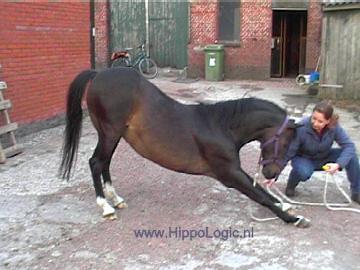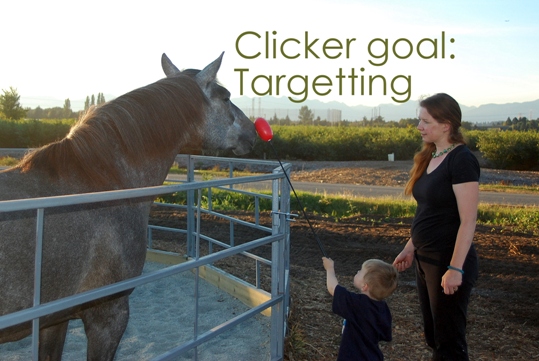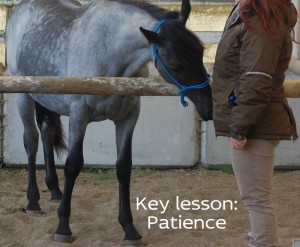Not too long ago I wrote a blog about the ‘boring basics‘ which appeared not to be boring at all!
I realized that some equestrians maybe still consider basic exercises as ‘exercises’ or ‘basic’ while they can be so much more. I consider HippoLogic’s Key Lessons (Your Key to Success in Positive Reinforcement training) not basic exercises, I consider them tools. Important and powerful training tools.
In this series I will explain how you can turn exercises into valuable training tools.
Key Lessons for Horses
The 6 fundamental exercises in clicker training that can become your most valuable tool are:
- ‘Table Manners’ for horses
- ‘Patience’
- Targeting
- Mat Training
- Head Lowering
- Backing
How you can turn basic exercises as ‘Table Manners’ for Horses and ‘Patience’ into tools is discussed in part I. Read part I here.
From exercise to training tool to success strategy
At first the Key Lessons are goals in training, but once you master these exercises you can start using them as tools. They will help you get other, more complex behaviours. Once you are using them as tools you will notice that they become your success strategy. That is what I teach in my online course Key Lessons, Your Key to Success in Positive Reinforcement Horse Training.
Targeting
The Key Lesson Targeting is a goal when you have to teach your horse how to target. You teach him to touch an object with his nose.
 Once your horse can do this and you’ve put the behaviour on cue you can start using the target to create other behaviour. For instance you keep the target out of reach and ask your horse to ‘touch target’. Instead of marking (=clicking) the behaviour ‘touch’, you click for the behaviour ‘walking’ (towards the target). In this way you use the target as a tool te get other behaviour.
Once your horse can do this and you’ve put the behaviour on cue you can start using the target to create other behaviour. For instance you keep the target out of reach and ask your horse to ‘touch target’. Instead of marking (=clicking) the behaviour ‘touch’, you click for the behaviour ‘walking’ (towards the target). In this way you use the target as a tool te get other behaviour.
With a target you can get as many behaviours as your creativity lets you.
Start teaching your horse to use a stationary target. With a stationary target you can create a ‘safety blanket’ feeling for your horse. It is also a great place to send your horse to when you enter the stall, paddock or pasture with food.
I have seen trainers using a target on a very long stick to create rearing, you can use it to teach your horse to ‘follow a moving target’ so you can teach him to follow you.
If your horse often leaves you when you are working at liberty you can present the target as a reminder ‘good things happen’ when you pay attention to your trainer. Targeting also can be used to create Key Lessons ‘Head lowering’ and ‘Backing‘.
Mat training
Targeting is very, very versatile. Once your horse knows how to target with his nose you can ask him to target other body parts, like his feet.

You start training your horse to step onto a mat or piece of plywood. Once your horse is confident to do this and he knows the cue for it you can transfer the behaviour ‘step on the mat’ to other objects. Like a pedestal, a tarp or a trailer ramp. Of a wooden bridge that you encounter on a trail or the cover of a manhole or a horse scale, like in the picture below.

Once your horse knows how to target with his nose and his feet it is not that hard to ask him to target other body parts. Once you realize that now you know this Key Lesson it is easy to see how you can use targeting as a training tool, right?
Ear target, to help clean them, overcome head shyness and is a great aid in teaching your horse to ‘self halter/bridle’.
Mouth and lip target to teach to accept oral medication like worming paste, accept a bit, check his teeth or teach your horse to pick up items and give them to you.
Knee target to teach the Spanish walk, Spanish trot, put his hoof on a hoof jack or to teach your horse ‘jambette’.
Hip target to align your horse at the mounting block, travers, move over and so on.
Eye target to clean eyes, put ointment in, calm him down.
Sternum target to teach classical bow
Chin target to teach positions of the head
Tail target to teach backing
Hoof target to lift hoofs, use a hoof jack, put hoof in boots.
Your creativity is really the limit. If you can think it you can train it. This is why I call HippoLogic’s Key Lessons, your Key to Success.
Check out the webinar I have done about this subject:
Please share
If you think this is a blog that someone can benefit from, please use one of the share buttons below. Or post your comment, I read them all! Comments are good reinforcers.
Or simply hit the like button so I know you appreciated this blog. Thank you!
Sandra Poppema, B.Sc.
My mission is to improve human-horse relationships. I reconnect horse women with their inner wisdom and teach them the principles of learning and motivation, so they become confident and skilled to train their horse in a safe and effective way that is a lot of FUN for both human and horse. Win-win.
Sign up for HippoLogic’s newsletter (it’s free and it comes with a reinforcer) or visit HippoLogic’s website and discover my online 8 week course ‘Key Lessons, Your Key to Success in Positive Reinforcement Horse Training‘ that will change your life.



 This exercise starts out to teach people to train their horse not to mug them and to be ‘polite’ around food. With ‘polite’ I mean the food always goes to the horse, never the other way around. Treats need to be carefully taken off of the hand with their lips, not the teeth. Only the treat is eaten, not the fingers and so on. Basically you just teach your horse not to forage for food. You train them to suppress their natural exploration behaviour.
This exercise starts out to teach people to train their horse not to mug them and to be ‘polite’ around food. With ‘polite’ I mean the food always goes to the horse, never the other way around. Treats need to be carefully taken off of the hand with their lips, not the teeth. Only the treat is eaten, not the fingers and so on. Basically you just teach your horse not to forage for food. You train them to suppress their natural exploration behaviour.









You must be logged in to post a comment.